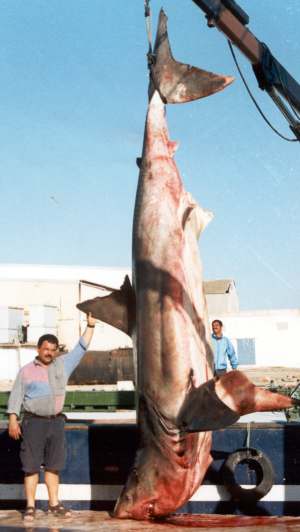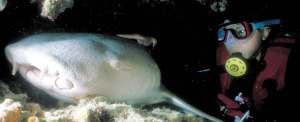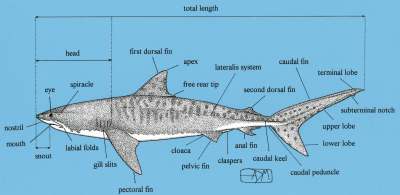Alessandro De Maddalena
Wrongly maligned as man-eating monsters, sharks seldom attack humans,
but their populations are being rapidly depleted by overfishing and
other human activities.
 ention the word sharks, and what goes ention the word sharks, and what goes
 |  The
great white shark is one of the few shark species known to attack
humans. This 17-foot specimen was caught in a tuna trap off the coast
of Tunisia. Populations of this species have been depleted by
intentional and accidental catches, and some countries have listed it
as endangered. WALID MAAMOURI The
great white shark is one of the few shark species known to attack
humans. This 17-foot specimen was caught in a tuna trap off the coast
of Tunisia. Populations of this species have been depleted by
intentional and accidental catches, and some countries have listed it
as endangered. WALID MAAMOURI
through your mind? The movie Jaws? Ferocious giants of the sea ripping
up helpless swimmers, surfers, and boaters? The word is even applied to
people who engage in extortion, preying on others through deceptive
practices.
Yes, sharks are
predators that occupy the top layer of the marine food web, and many
are large and powerful enough to be capable of harming a person. Even
so, only certain species pose a definite danger to people who venture
into their habitat, while most are inoffensive. On a worldwide scale,
the number of shark attacks on humans amounts to about 100 per year, of
which only 5 to 15 are fatal. In most cases, the attack ends after the
initial contact and the shark does not kill or eat the victim.
By comparison,
many more people die each year from water-related activities that do
not involve sharks. Even the number of casualties from lightning
strikes is much higher. Unfortunately, each shark attack is
sensationalized by the media, and these stories then shape public
perception of sharks.
On the other hand,
human activities exert a key influence on shark survival. In recent
years, as fisheries relying on other types of fish have declined, shark
captures--both intentional and accidental--have greatly increased.
According to an estimate reported online by NOAA Fisheries, over 100
million sharks are killed each year. Consequently, populations of many
species have been dramatically reduced.
To gain a better
perspective on these conflicting issues, it is important to understand
sharks in terms of their biological features, life cycles, dietary
habits, and role in marine ecosystems. In addition, we need to consider
how they are affected by commercial and recreational fishing.
Characteristics of sharks
 harks can be
found in all the world's seas, from the equator to the polar regions,
in shallow as well as deep waters. We are currently aware of about 480
species of sharks, occurring in a variety of shapes and sizes. Some
species, labeled benthic, dwell mainly on the seafloor. Others, known
as pelagic, spend much of their time navigating the open seas, although
they may also be found on the ocean bottom. Some species inhabit rivers
and lakes. harks can be
found in all the world's seas, from the equator to the polar regions,
in shallow as well as deep waters. We are currently aware of about 480
species of sharks, occurring in a variety of shapes and sizes. Some
species, labeled benthic, dwell mainly on the seafloor. Others, known
as pelagic, spend much of their time navigating the open seas, although
they may also be found on the ocean bottom. Some species inhabit rivers
and lakes.
One important
distinguishing feature of sharks is that their skeletons are made of
cartilage, while those of most other types of fish are made of bone.
Other cartilaginous marine animals include rays, skates, and chimaeras,
and they--as well as sharks--are grouped in the class Chondrichthyes.
Bony fishes, on the other hand, are placed in the class Osteichthyes.
Generally
speaking, a shark has a streamlined body with a long, flattened snout,
a parabolic mouth on the ventral (lower) side, and eight fins: two
pectoral and two pelvic fins, and one each of the first dorsal, second
dorsal, anal, and caudal (tail) fins. The upper lobe of the caudal fin
is noticeably longer than the lower one. Furthermore, the male's pelvic
fins are extended to form a pair of organs called claspers, which are
used to impregnate females.
The body shape,
however, varies according to the way of life of the species. For
example, fast-swimming mackerel sharks have a large, conico-cylindrical
shape; benthic cat sharks have long, slender bodies; and benthic angel
sharks and saw sharks are highly flattened in shape. Hammerhead sharks
have unique, rectangular heads.
Minimizing the Risk of Shark Attacks
Shark attacks on
humans are rare, with encounters occurring mainly near the shore.
Sharks are often found inshore of a sandbar or between sandbars, where
they may be trapped during low tide, and near steep drop-offs, where
their prey tend to congregate. To minimize the risk of being attacked
by a shark, it is important to take the following precautions.
When swimming at a beach, stay in a group and do not go too far from the shore.
Avoid being in the water during the hours of twilight, early morning, and darkness, when sharks are most active.
Stay out of the water if you are bleeding.
Do not enter the water wearing shiny jewelry or bright clothing.
Avoid areas being used by fishermen, especially if you see diving birds or other signs of bait fishes and feeding activity.
Exercise caution when entering murky waters and areas near sandbars or steep drop-offs.
Do not enter the water if sharks are known to be present, and evacuate the water if you see a shark.
Condensed from
information provided by NOAA Fisheries at
www.mfs.oaa.gov/sharks/Press--Kit--Sharks.htm and the Florida Museum of
Natural History at
www.flmnh.ufl.edu/fish/Sharks/Attacks/relariskreduce.htm. |
The world's largest
fish is the whale shark (Rhincodon typus), which may reach 65 feet in
length. The great white shark (Carcharodon carcharias) can attain a
maximum length of more than 20 feet [see "Marine Predator
Extraordinaire," The World & I, November 1994, p. 218]. Most shark
species, however, are under 5 feet. The smallest of them is the dwarf
lanternshark (Etmopterus perryi), only about 6 inches at maturity.
Sharks differ from
bony fishes in several ways, in addition to the differences in skeletal
composition. For instance, most bony fishes have a swim bladder in
their upper body cavity. It is a gas-filled sac that lends buoyancy by
offsetting the weight of bony tissue. Sharks lack this bladder, but
they are only slightly heavier than seawater because of their light,
cartilaginous skeleton and huge, oily liver. Moreover, the gills of
bony fishes are covered by a flap called an operculum, while sharks'
gill slits are uncovered.
A shark's skin is
covered by small (usually microscopic) toothed structures known as
dermal denticles or placoid scales, which help reduce friction while
swimming. These structures generally point toward the tail (though in
some cases they are vertically oriented), so that rubbing the skin from
tail to head gives a sandpapery feeling.
A shark's mouth
contains 5 to 15 parallel layers of teeth so that when the front teeth
break off, as happens frequently, new ones quickly take their place.
Depending on the species, a shark may shed 10,000 to 50,000 teeth in
its lifetime. The teeth vary in shape, according to the animal's diet.
For instance, the great white shark has sharp, wide teeth, suitable for
shearing or sawing pieces from large animals. The shortfin mako (Isurus
oxyrinchus) has narrow, curved teeth adapted for seizing smaller,
fast-moving schools of fish. The common smooth hound (Mustelus
mustelus) has smooth, flattened teeth that enable it to crush hard prey
such as mollusks and crustaceans.
Sharks have a
highly developed nervous system, with several types of senses that are
mainly used to find and catch prey. These senses include (1) smell and
taste (chemoreception); (2) vision (photoreception); (3) hearing,
touch, and a lateral line system (mechanoreception); and (4) ampullae
of Lorenzini (electroreception). The lateral line system--consisting of
a series of sensory canals just beneath the skin, running lengthwise on
each side of the body--enables the animal to detect vibrations and
changes of pressure in the water. The ampullae of Lorenzini are
receptors (on the shark's head) that can detect weak electric fields,
such as those produced by the muscular contractions of prey.
Reproduction and feeding
 ompared with
other types of fish, sharks have a slow growth rate. As a result, their
sexual maturation takes a long time--from 2 to 20 years, depending on
the species. In addition, they produce relatively small numbers of
young--the litter size usually ranges from 2 to 20. In many cases,
litters are produced only every alternate year. ompared with
other types of fish, sharks have a slow growth rate. As a result, their
sexual maturation takes a long time--from 2 to 20 years, depending on
the species. In addition, they produce relatively small numbers of
young--the litter size usually ranges from 2 to 20. In many cases,
litters are produced only every alternate year.
 |  A
nurse shark is normally inoffensive to humans unless provoked. Its
flattened body helps it hide on the seafloor where it dwells. A
nurse shark is normally inoffensive to humans unless provoked. Its
flattened body helps it hide on the seafloor where it dwells.
COREL STOCK PHOTO
The reproductive
methods used by sharks may be classified into three types, in each of
which the eggs are fertilized within the female. In one group of
species, described as oviparous, the females lay horny egg cases, each
containing an embryo nourished by a yolk sac. The females of a second
group, termed aplacental viviparous, give birth to live young that were
sustained in the uterus by a yolk sac. In a third category, called
placental viviparous, the females produce live young that were nurtured
by placenta in the uterus.
The average
gestation period is 9--12 months, but it takes up to 22 months for the
piked dogfish (Squalus acanthias). When the pups are born, they are
fully formed and ready to feed. The maximum life span of a shark ranges
from 10 to 70 years or more, but members of most species live 20--30
years.
The diverse
species of sharks specialize in pursuing specific groups of prey, but
humans are not on the menu of any species. Some of the giant
species--namely, the whale shark, basking shark (Cetorhinus maximus),
and megamouth shark (Megachasma pelagios)--are content to feed on
planktonic organisms, including small crustaceans, fish eggs, and fish
larvae. The diet of other species includes other types of fish,
mollusks, crustaceans, worms, echinoderms (sea stars and sea urchins),
pinnipeds (seals and sea lions), cetaceans (whales and dolphins),
marine turtles, sea snakes, and seabirds. Most sharks feed mainly on
live prey, but some are scavengers, feeding on dead animals.
Given the large
size of most sharks, they themselves are excluded from predation by
most other animals. Their eggs and young, however, are susceptible to
certain types of fishes and mollusks. In addition, adult sharks are
eaten by a few species, including humans, other sharks, some bony
fishes such as large groupers, and a few marine mammals such as the
killer whale and sperm whale.
As predators and
scavengers, sharks play an important ecological role in marine
communities. From their position as apex predators, they exert
substantial control over the sizes of the populations of many species
on lower levels of the food web. Consequently, they contribute to the
stability of marine ecosystems and maintain biodiversity.
Attacks on humans
 hile sharks do
not normally pursue humans as prey, some people are occasionally
attacked by certain species. The three species responsible for most
attacks are the great white shark, tiger shark (Galeocerdo cuvier), and
bull shark (Carcharhinus leucas). hile sharks do
not normally pursue humans as prey, some people are occasionally
attacked by certain species. The three species responsible for most
attacks are the great white shark, tiger shark (Galeocerdo cuvier), and
bull shark (Carcharhinus leucas).
Equipped with wide
mouths and big, serrated teeth, these powerful creatures normally feed
on large prey. In addition, they are widely distributed in the seas of
the world. Sometimes they have been aggressive toward  |  The
author displays the jaws of an 18-foot great white shark caught off
Martigues, France. The jaws are preserved at the Oceanographic Museum
of Monaco. ALESSANDRA BALDI / PERMISSION FROM MUSÉE OCÉANOGRAPHIQUE DE MONACO The
author displays the jaws of an 18-foot great white shark caught off
Martigues, France. The jaws are preserved at the Oceanographic Museum
of Monaco. ALESSANDRA BALDI / PERMISSION FROM MUSÉE OCÉANOGRAPHIQUE DE MONACO
humans without apparent provocation, but there have been many reports of these animals
approaching divers and bathers closely without showing any aggressive tendencies.
Other species that
have occasionally harmed humans are the blue shark (Prionace glauca),
shortfin mako, great hammerhead shark (Sphyrna mokarran), oceanic
whitetip shark (Carcharhinus longimanus), lemon shark (Negaprion
brevirostris), dusky shark (Carcharhinus obscurus), gray reef shark
(Carcharhinus amblyrhynchos), bronze whaler shark (Carcharhinus
brachyurus), blacktip reef shark (Carcharhinus melanopterus), and
blacktip shark (Carcharhinus limbatus).
The attacks may
occur in water that is shallow or deep, warm or cold, but most have
been recorded in areas favorable for recreational swimming,
particularly in Florida. Not only is Florida's coastline popular with
swimmers and surfers, but many potentially dangerous sharks inhabit
those waters.
What motivates a
shark to bite a human? It appears that in most cases, the animal
mistakenly identifies the person as a marine mammal or other type of
prey. After taking a bite, it discovers its mistake and releases the
person without inflicting additional injury. Alternatively, the shark
may be using a defensive tactic, to protect itself from what it may
perceive to be a potential threat. Repeated attacks on a human victim
are rare. Whatever the case, it is important to take certain
precautions to minimize the risk of being bitten by a shark [see
"Minimizing the Risk of Shark Attacks" on p. 152].
Depletion of sharks
 or centuries,
fishermen around the world relied on traditional methods to catch
sharks (as well as other types of fish), and shark populations remained
stable. Recently, however, several factors have led to serious
depletion of shark populations. or centuries,
fishermen around the world relied on traditional methods to catch
sharks (as well as other types of fish), and shark populations remained
stable. Recently, however, several factors have led to serious
depletion of shark populations.
One problem is
that large-scale fishing methods have substantially reduced stocks of
bony fishes, and commercial fishermen have compensated by vastly
increasing the capture of sharks. Today, most shark species are being
overfished in many seas of the world. Many species yield marketable
products--namely, their meat, cartilage, skin, and oil. Shark meat is
consumed in almost all Atlantic and Mediterranean countries, where it
is traded fresh, chilled, frozen, and dried.
Moreover, an
estimated 50 percent of the sharks captured worldwide are part of what
is called the bycatch--that is, the fish caught accidentally, while
attempting to catch other species. A major factor contributing to this
problem is the use of gear known as pelagic longlines, generally
employed to catch swordfish and tuna. This gear consists of
single-stranded fishing lines, each stretching anywhere from 10 to 40
miles, carrying an average of 1,500 baited hooks. In some areas, the
number of sharks caught accidentally in longlines reaches 90 percent of
total captures. Species such as the blue shark and shortfin mako are
especially vulnerable to this method.
 |  Exterior
anatomy of a tiger shark. The spiracle, a small opening behind each
eye, functions with the gills to absorb oxygen from the water. The
lateralis system consists of sensory tubes (under the skin) that help
the animal detect vibrations and pressure changes in the water. The
claspers, occurring only on the male, are used to impregnate the
female. ALESSANDRO DE MADDALENA Exterior
anatomy of a tiger shark. The spiracle, a small opening behind each
eye, functions with the gills to absorb oxygen from the water. The
lateralis system consists of sensory tubes (under the skin) that help
the animal detect vibrations and pressure changes in the water. The
claspers, occurring only on the male, are used to impregnate the
female. ALESSANDRO DE MADDALENA
Another problem is
that large numbers of sharks are killed and wasted through the practice
of finning them at sea. Shark fins are often used in Asian soups, and
their market value is much higher than that of other shark products.
Consequently, some fishermen remove the fins and discard the rest of
the shark's body into the sea. This practice has recently been banned
by Canada, Brazil, the United States, and the European Union.
Several shark
species are caught by recreational anglers, many of whom consider even
young sharks to be "large fishes." The population of blue sharks in the
Adriatic Sea has been devastated by years of unmonitored, unregulated
sportfishing in their nursery area. Thresher sharks (Alopias species)
have also been greatly affected by sportfishing.
Furthermore, shark
populations are being adversely affected by human activities that are
less direct but just as harmful. One such factor is overfishing of
their prey, such as tunas, mackerels, pilchards, rays, squids, and
crustaceans. Other indirect factors include environmental pollution and
habitat destruction. If certain toxic chemicals are ingested by
animals, they accumulate in each individual and are passed up the food
web, from prey to predator. Consequently, apex predators such as sharks
are at higher risk of receiving concentrated toxins from their prey.
Mediterranean Shark Research Group
The Mediterranean
Shark Research Group (MSRG) was initiated in the summer of 2000 by some
researchers at the Marine Biological Station of Piran (in Slovenia),
the Barcelona Museum of Zoology, and the Italian Great White Shark Data
Bank. Their purpose was to establish and expand an information exchange
network among ichthyologists studying sharks of the Mediterranean, in a
spirit of mutual collaboration. Today, the group includes 30
researchers from 10 countries and has launched several projects,
including studies on shark capture in the Mediterranean by
sportfishermen and the occurrence of shortfin makos along Italian
coasts. It is also investigating the age and growth of the basking
shark in collaboration with the Natal Sharks Board of South Africa.
The MSRG programs
are cause for optimism, as they indicate that some positive changes are
finally occurring. The group, however, faces serious difficulties
because the corresponding national governments display little interest
in these projects. The MSRG alone, with its members working on a
voluntary basis, will not ensure the conservation of Mediterranean
shark populations. The governments of major European shark-fishing
countries should put far more resources into research on shark biology
and fisheries, and the European Union must finally assume an important
role in shark conservation in both Atlantic and Mediterranean waters.
--A.D.M
|
Sharks are much
more vulnerable to overexploitation than bony fishes, for several
reasons. Their growth rate is slow, their sexual maturation and
gestation periods are long, and they produce small litters of young.
The exploitation of pups in a nursery area can be particularly
devastating for their population. By contrast, bony fishes lay numerous
eggs, and they grow and reproduce much faster. As a result, shark
populations recover from overexploitation far more slowly.
The problem of
overfishing of sharks is difficult to quantify. Annual landings of
cartilaginous fishes, as reported to the UN Food and Agriculture
Organization, amount to around 820,000 metric tons. The actual total,
however, is surely much higher because large quantities of catch are
not recorded. Every year, thousands of dead sharks are thrown back into
the sea for lack of demand in many countries.
The piked dogfish
is the leading commercial shark taken in the world. In the Atlantic
Ocean, species such as the porbeagle (Lamna nasus), shortfin mako,
piked dogfish, smooth hounds (Mustelus species), and requiem sharks
(family Carcharhinidae) are heavily exploited and their stocks have
dramatically declined. Species that have become sporadic or rare in the
Mediterranean Sea include the great white shark, shortfin mako,
porbeagle, sandtiger (Carcharias taurus), smooth hammerhead (Sphyrna
zygaena), sandbar shark (Carcharhinus plumbeus), bramble shark
(Echinorhinus brucus), and angular roughshark (Oxynotus centrina).
The decline of
shark populations warrants an urgent investigation into the status of
various species. To take effective conservation and management
measures, further research needs to be performed to determine specifics
about their life cycles, feeding habits, distribution, and exploitation
from various seas. The information obtained, coupled with long-term
analyses of their relative abundance, would offer insights into
restoring their populations. Of course, the protection of sharks also
requires protecting their prey and managing other fisheries in which
sharks constitute a significant bycatch.
The absence of
research and management efforts in many countries is leading to the
extinction of several species of sharks. In the Mediterranean area, no
country keeps accurate records of each species captured; and in the
entire Atlantic-Mediterranean region, only a few nations (particularly
the United States and Canada) have developed specific shark-management
programs. In some countries, certain species--such as the basking shark
and great white shark--are listed as protected. That, however, is not
enough; the list of endangered species is far from complete. Moreover,
fishermen often breach regulations and capture even the handful of
protected species.
Researchers in the
Mediterranean area are fully aware of this situation, but European
governments seem to lack interest in shark conservation. Shark research
is almost entirely neglected in favor of studying bony fishes, such as
tuna and swordfish, which are commercially important.
The threat to
shark populations is part of an immense problem confronting world
fisheries. Most seas have been fished to the limits of their
productivity. Advances in fishing technologies, along with rising
demands by a growing human population, have led to heightened efforts
to catch fish, mollusks, and crustaceans. As a result, the stability of
marine ecosystems is in serious danger. It is incumbent on us to devise
appropriate strategies to protect and restore the populations of these
sea creatures. 
On the Internet
NOAA Fisheries Shark Web Site
www.mfs.oaa.gov/sharks
ReefQuest Centre for Shark Research
www.elasmo-research.org/index.html
Sharks: Florida Museum of Natural History
www.flmnh.ufl.edu/fish/Sharks/sharks.htm
Alessandro De Maddalena is curator of the Italian Great White Shark
Data Bank and a founding member of the Mediterranean Shark Research
Group.
|
